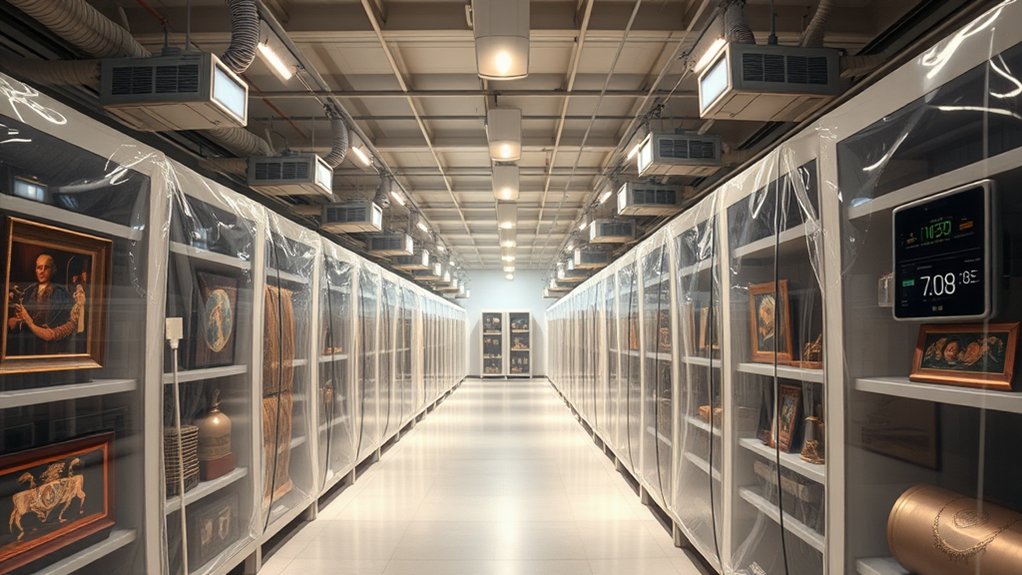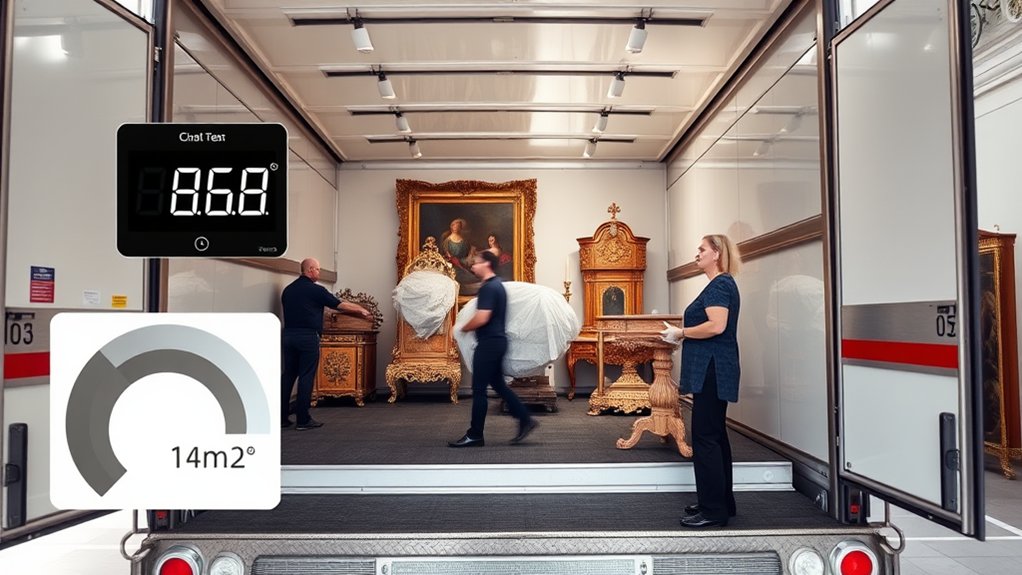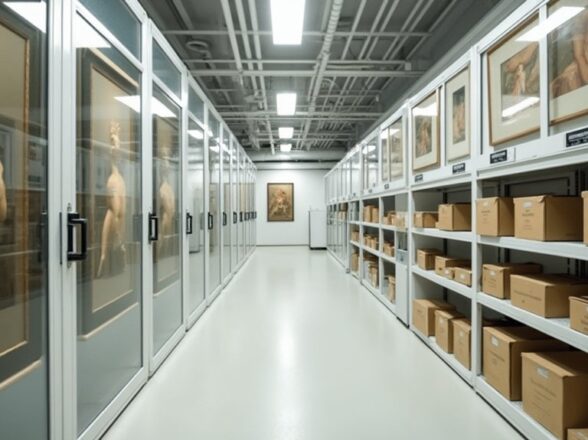What Is Climate-Controlled Moving for Art and Antiques? Why Temperature and Humidity Matter

Climate-controlled moving for art and antiques is a specialized service that protects valuable items during transport. It keeps temperature and humidity levels stable to prevent damage. Ideal temperatures range from 65°F to 75°F, while humidity should stay between 40% and 50%. Fluctuations can cause warping, fading, and brittleness. Controlled environments help avoid these issues, maintaining the integrity and value of your items. Though it may have higher costs, the benefits include reduced restoration expenses and better preservation. Understanding these key factors can help you make informed decisions about protecting your treasured possessions.
Importance of Climate Control

Preserving artwork and antiques is essential, and climate control plays an important role in that process. You need to maintain a stable temperature between 65°F and 75°F and a relative humidity of 40-50% for effective climate-controlled storage. Fluctuations in temperature can lead to cracking and warping, while high humidity levels over 70% can accelerate rust and tarnishing. Conversely, low humidity below 30% can cause materials like wood and paper to shrink and become brittle. By using climate-controlled storage, you protect your valuable items from pests and pollutants that can cause irreversible damage. Proper climate control not only extends the lifespan of your collections but also preserves their monetary and sentimental value, reducing the need for costly restorations. In addition to maintaining the right temperature and humidity levels, utilizing high-quality materials for wrapping and storing artwork and antiques can further enhance their protection. Choosing the best storage options for art includes using acid-free packaging, UV-filtering glass, and sturdy, climate-controlled containers that provide an extra layer of defense against environmental threats. By prioritizing these comprehensive storage solutions, collectors can ensure that their treasures remain in pristine condition for generations to come.
Impact of Temperature Fluctuations
When temperature fluctuations occur, they can wreak havoc on your valuable antiques and artwork. These changes can cause structural damage, leading to warping, cracking, or fading. Ideally, you should maintain a temperature between 55°F and 85°F to protect your items. Sudden temperature shifts stress materials, causing them to expand and contract. This can damage joints in furniture and artworks. Heat also accelerates the deterioration of chemically unstable items like photographs and certain paintings. Keeping stable environmental conditions during moving and storage is essential. Utilizing climate-controlled trucks ensures that sensitive items are transported without exposure to harmful temperature changes. Below is a quick reference table to understand the effects of temperature fluctuations:
| Impact | Description |
|---|---|
| Warping | Changes in shape due to heat |
| Cracking | Fractures from rapid temperature shifts |
| Fading | Loss of color intensity over time |
| Deterioration | Increased decay in sensitive materials |
| Structural Damage | Compromised integrity of antiques and art |
Role of Humidity in Preservation

Humidity plays an essential role in preserving art and antiques. You need to measure humidity accurately, as both high and low levels can cause significant damage to materials. Control strategies are vital to maintain ideal humidity levels, typically between 40% and 50%, to protect your valuable items.
Humidity Measurement Types
Understanding how humidity affects art and antiques is essential for their preservation. There are two main humidity measurement types you should know:
- Absolute humidity measures the actual moisture in the air.
- Relative humidity (RH) compares current moisture levels to the air's maximum capacity at a certain temperature.
For preservation, maintaining ideal RH levels between 40% and 50% is vital. Levels above 70% can lead to issues like mold and rust, while levels below 30% can cause shrinkage and brittleness. Fluctuations in humidity can result in irreversible damage to your items. Consequently, consistent environmental conditions are key to protecting valuable art and antiques from physical changes that may occur due to improper humidity levels. Additionally, climate-controlled storage units are crucial in maintaining these consistent conditions, as they can regulate temperature and humidity to prevent damage to valuable items.
Effects on Materials
The preservation of art and antiques hinges on the delicate balance of humidity in their environment. High humidity can cause serious damage to materials, promoting rust, tarnishing, and mold growth. This is especially true for organic materials like wood and paper. On the other hand, low humidity can lead to shrinkage and brittleness, making materials fragile and more prone to cracking. Fluctuations in humidity can cause organic materials to expand and contract, which results in structural damage over time. Maintaining a temperature-controlled environment with ideal humidity levels between 40-50% is essential. This helps prevent degradation and guarantees the longevity of your valuable items, avoiding the need for costly restoration.
Control Strategies for Preservation
While fluctuating humidity can wreak havoc on your art and antiques, implementing effective control strategies can preserve their integrity. To maintain ideal humidity levels, aim for 40-50%. Here are some strategies to take into account:
- Use dehumidifiers to reduce excess moisture.
- Invest in air conditioning to control temperature and humidity.
- Regularly monitor humidity levels with multiple gauges.
- Store items in climate-controlled environments during moving and storage.
When relocating valuable artwork, consider using specialized moving techniques to ensure their safe transport. These control strategies are crucial for art preservation, especially for organic materials like wood and leather. High humidity can lead to mold, while low levels can cause shrinkage. By staying proactive, you can prevent damage and guarantee your valuable collections remain in excellent condition for years to come.
Benefits of Controlled Moving
When you choose climate-controlled moving for your art and antiques, you're not just ensuring safe transport; you're actively protecting your valuable items from potential damage. This method maintains a stable temperature between 65°F and 75°F, which prevents harm from extreme heat or cold. By keeping relative humidity levels between 40-50%, you reduce the risk of mold and deterioration of materials like wood and paper. Controlled environments minimize fluctuations that can cause cracking or warping. Additionally, specialized moving services often include air filtration systems that guard against dust and pollutants. Ultimately, utilizing climate-controlled moving helps you avoid costly restoration needs by proactively safeguarding your items against environmental damage during transit, ensuring they arrive in pristine condition. Moreover, many climate-controlled facilities in the UAE offer advanced access control systems as part of their security measures, ensuring the safety and integrity of your valuable items during storage.
Best Practices for Transporting Antiques

Successfully transporting antiques requires careful planning and attention to detail. To guarantee the safety of your valuable items, follow these best practices:
- Use climate-controlled moving trucks equipped with HVAC systems to maintain stable temperature and humidity.
- Secure antiques with proper packing materials like acid-free tissue and bubble wrap to protect against impacts and environmental changes.
- Regularly monitor conditions inside the moving vehicle using hygrometers and thermometers.
- Plan your route to avoid extreme weather and allow adequate time for loading and unloading.
Evaluating Climate-Controlled Services
Transporting antiques requires more than just careful packing; it’s crucial to take into account the climate conditions during transit. When evaluating climate-controlled services, consider their ability to maintain ideal temperature and humidity levels. This protection is important for your art collection, as fluctuations can cause irreversible damage. Look for moving services that use specialized vehicles equipped with climate control technology. They should also have monitoring systems that provide real-time data on temperature and humidity, allowing for immediate adjustments if needed. Additionally, check if they utilize archival-quality packing materials to safeguard sensitive items. Investing in these services can save you from costly restoration expenses caused by temperature spikes or excessive humidity during transport. Moreover, it’s wise to seek out companies that specifically offer fine art moving services, as they often have the expertise required to handle delicate pieces. These services typically include trained professionals who understand the intricacies of packing, loading, and transporting antiques safely. By choosing a provider that specializes in fine art logistics, you can ensure that your valuable items are in capable hands throughout the entire moving process.
Frequently Asked Questions
What Is the Humidity Control for Artwork?
Humidity control for artwork's essential. You need to monitor moisture levels, as high humidity can cause mold and damage, while low humidity leads to brittleness. Employ preservation techniques to maintain a stable environment for your pieces.
Why Is Temperature and Humidity Important?
Temperature and humidity's essential for art preservation techniques. You'll notice humidity effects and temperature fluctuations can cause damage, like cracking or warping. Keeping conditions stable protects your valuable pieces from irreversible harm, ensuring they last.
What Is the Climate Control for Paintings?
When it comes to art preservation techniques, nothing's more essential than climate control for paintings. You'll want ideal painting storage solutions and artwork transportation methods to protect your valuable pieces from damage caused by fluctuating conditions.
What Is the Difference Between Temperature Controlled and Climate Controlled?
You need to understand that temperature regulation focuses on consistent heat levels, while climate stability includes humidity control. For art preservation, both are essential; without humidity management, your valuable items can suffer irreversible damage.
Conclusion
In conclusion, climate-controlled moving is essential for preserving art and antiques. Temperature and humidity can greatly impact these valuable items. For example, a 10-degree temperature shift can cause materials to expand or contract, potentially leading to damage. By using climate-controlled services, you guarantee that your possessions are protected during transport. Following best practices helps maintain their condition. Ultimately, investing in controlled moving safeguards your treasures for future enjoyment and appreciation.
Related posts
Recent posts
Post Categories
Tags
Subscribe




